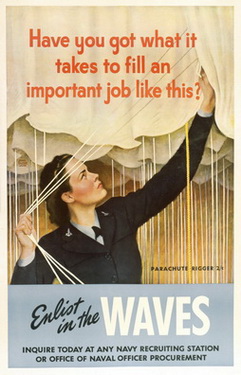Recruiting Posters For Women
This exhibit contains the works in the Navy Art Collection that relate to the recruitment of women during World War II. This includes not only finished posters, but also original artwork for the posters.
Two of the most prolific and well-recognized artists to contribute to the Navy's campaign for the recruitment of WAVES were John Philip Falter (1910-1982) and McClelland Barclay (1891-1943). Both men had successful careers in magazine illustration before the Second World War and were well suited for this particular type of persuasive and dramatic illustration, geared largely towards female readers.
John Philip Falter developed his artistic skills at an early age, even designing a mural for his local soda shop when still a teenager. He expanded his talents at the Kansas City Art Institute and then the Art Students League of New York and the Grand Central School of Art where he was exposed to the techniques of some the most prestigious illustrators of the Golden Age of Illustration (1880s-1920s).

Throughout the nation, recruiting posters were placed in countless prominent public locations. One might see Falter's and Barclay's designs several times throughout the day during 1943. The Navy often reused the same designs for multiple formats with differing text. Posters hung in post offices, libraries, grocery and department stores, on billboards and even in public restrooms. Car cards, or smaller rectangular posters, were mounted in subway cars by transit authorities in major metropolitan areas. Window cards were displayed in the storefronts of businesses.
The Navy was looking for educated, capable, virtuous, and feminine women. Accordingly, Falter's and Barclay's WAVES are simultaneously glamorous and serious. They possess a conventional feminine appearance, wearing blush, lipstick and nail polish. Yet the artists depicted them doing important, manicure-marring work: rigging parachutes and operating radios. In truth, WAVES also did much more labor-intensive work as well, such as machine assembly, repair work and kitchen patrol, but artists did not depict those jobs in recruitment posters. Obviously, many WAVES did not resemble the young, Caucasian, perfectly-proportioned poster gals. The Navy recruited women of color and differing ethnic origins, as well as older married and widowed women, on the condition that they did not have dependent children nor become pregnant. The tactics employed by the Navy's recruiting bureau in the posters mirrored those of national advertisements and mass media at the time. It was no coincidence that Falter and Barclay, successful illustrators of popular magazines would become the Navy's preferred recruitment artists.